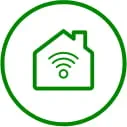If you've ever been on a video call when suddenly the connection gets choppy and pixelated, it might be because there's too much traffic on the network. When network traffic gets too heavy, your online experience suffers—whether you're streaming a show, gaming or on an important work call. Many internet service providers know they are going to run into congestion, especially at certain times of the day when more people come online. To ensure all their customers can stay online, they manage their network capacity. What does this mean? We talked to our Director of Network Architecture, Eric Rosenberry, to learn more about this tactic and why Ziply Fiber doesn't have to do it.
Q: Let's start with the basics. What is capacity management, in basic terms?
A: Any company that sells internet—whether it's cable, fiber or wireless—at some point must share data transmission. In our network, which is a Passive Optical Network (PON), each home gets a dedicated fiber strand to a hub in the neighborhood. This is also known as "fiber to the home," or "fiber to the premise." That connection is shared with up to 32 homes on a single fiber strand back to our Central Office. So, while part of the connection is dedicated fiber to the home, it eventually becomes a shared medium. Capacity management is about ensuring that this shared part of the network never gets overloaded.
Read more: Why fiber-to-the-home is the ultimate internet experience
Q: What happens when the network gets overloaded with too much data traffic?
A: When too many people try to use too much bandwidth at the same time, data packets can get dropped. That results in things like video quality dropping or phone calls stuttering. Cable networks are especially vulnerable to this because their infrastructure is older and more limited. They often expect congestion and try to manage it after the fact.
At Ziply Fiber, we try to prevent congestion altogether. Because our network is 100% fiber-optic, we naturally have more bandwidth and symmetrical speeds. We set alerts for our core network at 40% peak utilization, even during the busiest times. That way, we have plenty of headroom in case something fails, and traffic needs to reroute. We don't really have to manage capacity at all, because we have enough bandwidth to ensure data can always flow smoothly.
Q: Can you give a real-world example of network congestion and capacity management?
A: Sure. During the Mike Tyson–Roy Jones Jr. fight on Netflix, a lot of networks got overloaded. Ziply Fiber didn't. We saw a spike in traffic, but because we keep both our backbone and peering links (like with Netflix) well below capacity, our customers had no issues. That's what capacity management looks like when it works.
Q: Why is the difference between cable and fiber internet speeds and congestion so drastic?
A: Great question. Cable was originally built for one-way TV delivery, so upstream bandwidth is kind of an afterthought. They've improved it a bit, but it's still severely limited. With us, if you buy 1 Gbps down, you also get 1 Gbps up. Our upload and download speeds are symmetrical. Cable often only gives you 40 to 100 Mbps up—even if you're paying for a gig down. That difference really matters for things like video calls, cloud backups and gaming.
It also goes back to dedicated and shared connections. In our network, you might share your connection with 31 others at most. We run 10 Gbps downstream and roughly 8.5 Gbps upstream. That's not the case with cable, where hundreds of homes may share the same connection, and the network has far less capacity.
Read more: A brief history of fiber internet and why it matters now
Q: What about throttling? How does Ziply Fiber handle that?
A: We don't throttle. Period. Some providers try to identify streaming video or large downloads and deprioritize them to keep web browsing fast. We don't do that. Our only bandwidth "management" is enforcing your plan speed—if you pay for 100 Mbps, that's what we ensure you get. But we don't discriminate between types of traffic.
Q: Last thing: what would you say to someone choosing a new provider today? How is Ziply Fiber "future-proof"?
A: Ziply Fiber is built for the future because of how much headroom we design into our network. We're conservative with utilization. We overbuild. And fiber itself is fundamentally better. It can handle vastly more bandwidth than copper or coaxial cable. So, if you're thinking ahead to things like 8K streaming, smart homes, VR or cloud systems, you want a connection that won't need replacing in five years. That's fiber. That's Ziply.






